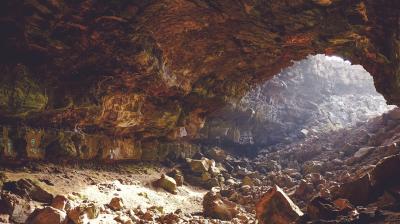
Top destinations to enjoy the outdoors in the
As winter temperatures drop, the thought of a warm-weather getaway becomes increasingly more desirable. While snow might be falling in some parts of the country, the USA has a wide range of landscapes, from beaches to deserts that boast temperate climates and make for...
read more
Here’s why the Al Hoota Cave is one of Oman’s most popular tourist attractions
Estimated to be over two million years old, the Al Hoota Cave is one of Oman's most popular natural tourist attractions. Located off route 21 between Nizwa and Bahla at the foot of Oman's epic mountain Jabal Shams, just two hours drive from Muscat, it is the first and...
read more
Tour venture ‘Moksha: Journey to the Self’ specialises in spiritual tourism
The travel enterprise takes pilgrims to heritage spots and spiritual destinations, both within the country and across the border Mochitha Prakriti feels liberated when she travels. Perhaps that is why she never feels the need to stay put even after travelling over 3...
read more
Gorgeous places in the US to enjoy outdoor winters
As winter temperatures drop, the thought of a warm-weather getaway becomes increasingly more desirable. While snow might be falling in some parts of the country, the USA has a wide range of landscapes, from beaches to deserts that boast temperate climates and make for...
read moreMillenials Benchmark Business Travel With Success
Almost 60 per cent of the people between 19-34 years of age consider business travel a status symbol and also an upward movement in life, reports the OnRoute survey by technology-driven budget hotel franchise brand FabHotels. "OnRoute - the Business Edition" is...
read more
Hamburg — straddling the dichotomies of being rich and being woke
The first time I visited Hamburg, the city gave me too much fodder for weather-talk. I even learnt the phrase Schmuddelwetter, dedicated to the entire region of North Germany. The somewhat untranslatable phrase simply means damp, hence wet and muddy weather, and it’s...
read more
Jet, set, jump
Stare a shark in the eye, leap off a cliff, zip across a waterfall and discover the adventurous side of South Africa I am on a narrow ledge, my hands atremble and breath, shallow. Above me is the arch of Durban’s Moses Mabhida Stadium, below, a grassy pitch. My goal:...
read more
Top 5 destinations for best travel experiences this September
September is probably one of the best months to travel almost anywhere in India. The weather is pleasant almost everywhere, with the monsoon slowly starting to subside by the end of August, it still helps to maintain cool weather needed for leisurely travel. Be it the...
read more
Experience the Greece countryside with Olive harvesting season
Greece has a long history of harvesting olives and is an olive producing country par excellence. The Mediterranean sun and the Aegean winds lend the fruit its unique taste. World's third largest producer of edible olives and olive oil, the country produces...
read more
Say what! Disneyland to sell alcohol for first time
This is a first for Disneyland - said to be one of the happiest places on earth - in its 63-year history! Adults visiting the Disneyland Park will finally be able to enjoy an alcoholic drink through a Star Wars-themed Oga's Cantina, which is scheduled to open next...
read moreScientists explore anti-cancer properties of traditional Siddha medicine, Pattu Karuppu
The allopathic system of medicine that treats symptoms of diseases using drugs came into existence in the 19th century. Before that, traditional medicines were common in many Asian countries, including India. A common drawback of allopathic medications is their undesired side effects caused by the adverse reactions of specific drug compounds with parts of our body. This has now rekindled interests among scientists in many traditional forms of medicine which are known to have no side effects. In one such study, researchers from the Manipal Institute of Technology, Manipal, Karnataka, and Anna University, Chennai, have evaluated the anti-cancer properties of Pattu Karuppu, a traditional Siddha medicine.
The Siddha system of medicine has its origin in Tamil Nadu and is similar to Ayurveda where extracts of different plants are used to treat various diseases. Pattu Karuppu is a mercury-based Siddha medicine prepared by the combination of acidic and alkaline substances and is rich in mercuric sulphide (HgS). While mercury is well-known for its curative effects, sulphur neutralises the toxicity of the medicine and makes it more effective.
While Pattu Karuppu is used to treat pain during menstruation (dysmenorrhoea), the absence of menstrual cycle (amenorrhoea) and delirium, its anticancer properties have not yet been explored. In this study, for the first time, the researchers look into the physical and chemical properties of this formulation and evaluate its effects on healthy cells.
The researchers examined a sample of Pattu Karuppu under an electron microscope and found that it contains nanoparticles with an average size of 20-80 nanometers. These come together and form a ‘broccoli-like’ structure. A chemical analysis of the compound showed that it mainly contains carbon and oxygen, with traces of mercury, arsenic and sulphur. “The sample was found to have stable and spherical (porous) particles with size ranges between 20-80 nanometres. The negatively charged, nanosize and relatively high surface area of the particles were used to evaluate its biological action”, say the authors.
The researchers then tested different concentrations of the formulation on cell lines in labs. They observed that the formulation could inhibit the growth of cancerous cells. To determine the ‘safe’ concentrations of Pattu Karuppu, they tested it on zebrafish. They observed that at high concentrations, the zebrafish developed problems with the rate of heartbeat (arrhythmias) and clotting of the blood cells in the heart. The results confirmed that a concentration of 100μg/ml was the safest, a finding that differentiates Pattu Karuppu from other toxic mercurials.
The study promises new hope for cancer patients whose life is bogged down by the side effects of radiation therapy and chemotherapy. As a next step, the authors plan to conduct similar studies on mouse models that could pave the way for effective anticancer drugs.
Asteroid 2010 WC9 to fly by Earth on May 15: Report
Space rock “Asteroid 2010 WC9” will have a near-Earth encounter, about half the lunar distance, on Tuesday, media reports said.The asteroid measures from 60 to 130 meters and moves at a speed of more than 28,000 miles per hour, WeekFacts.com reported late on Saturday.
Asteroid 2010 WC9 was “lost” and then found. The Catalina Sky Survey in Arizona first detected it on November 30, 2010, and astronomers watched it until December 1, when it became too faint to see.
The rock has completed its orbit and now returns to Earth eight years later.
At 11.05 p.m. on Tuesday, Asteroid 2010 WC9 will make its closest approach only 0.53 lunar distances (126.419 miles) from Earth.According to NASA’s Jet Propulsion Laboratory, this is the closest it will come in 300 years, the report said.
People can watch the spectacle on the Internet and the observatories of Northolt Branch in London will broadcast it live.
“We plan to broadcast this asteroid to our Facebook page if the weather forecast remains positive,” Guy Wells of the observatory was quoted as saying.
“The broadcast will last less than 25 minutes, since the asteroid will cross our field of view during this time period. The asteroid will move pretty fast (30 seconds of arc per minute).
“Our display will be updated every five seconds. We, of course, collect astrometric data while this happens, but the movement of the asteroid will occur every five seconds,” said Wells.
Jurassic fossil shows missing link in crocodile family tree
Researchers have found a “missing link” from a 180 million-year-old fossil that sheds light on how some ancient crocodiles evolved into dolphin-like animals.The fossil named Magyarosuchus fitosi in honour of the amateur collector who discovered it, Attila Fitos, was unearthed on a mountain range in north-west Hungary in 1996 and stored in a museum in Budapest.
The species featuring a large portion of backbone is nearly five metres long and had large, pointed teeth for grasping prey. It was one of the largest coastal predators of the Jurassic Period.
It also shares key body features seen in two distinct families of prehistoric crocodiles.
Besides being heavily armoured, the species also had a tail fin, suggesting it is a missing link in the family tree of crocodiles, the researchers noted, in the paper published in the journal PeerJ.
“This fossil provides a unique insight into how crocodiles began evolving into dolphin and killer whale-like forms more than 180 million years ago,” said Mark Young, of the University of Edinburgh’s School of GeoSciences in Britain.
“The presence of both bony armour and a tail fin highlights the remarkable diversity of Jurassic-era crocodiles.”The specimen was identified as a new species based on the discovery of an odd-looking vertebra that formed part of its tail fin.
Some Jurassic-era crocodiles had bony armour on their backs and bellies and limbs adapted for walking on land. Another group had tail fins and flippers but did not have armour, the researchers said.








